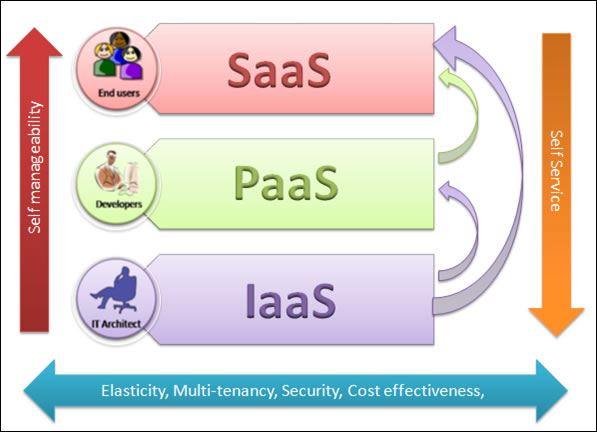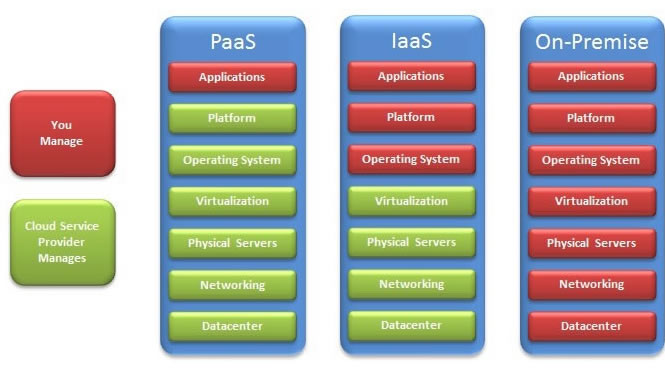|
CS6320: SW Engineering of Web Based Systems |
||||||
|
Cloud Computing Terminology
-
There are 3 defined service layers to the cloud: Infrastructure as a Service (IaaS), Platform as a Service (PaaS) and Software as a Service (SaaS).
-
You can think of these layers as a stack and PaaS sits in the middle, filling the void between IaaS and SaaS.


On Premise ---means out of the cloud, traditional web hosting
IaaS - Infrastructure as a Service
- IaaS provides a virtualization layer of elastic compute resources that are available on demand, such as Amazon EC2 or Rackspace Cloud.
- Examples of IaaS: Hardware, OS, Virtualization, Connectivity /Networking sofware
PaaS - platform as a service
- PaaS is the least well defined because people have very different vantage points of what a platform is
- Example Google App Engine = has platforms like JavaEE, Python, Go , but, also provides the complex IaaS underneath
- Yefim Natis for Gartner is quoted describing PaaS as “Anything that is not a business application or systems infrastructure is PaaS”.
- To me this is middleware and by this definition the PaaS is going to have a massive impact the way software is built.
- Examples of PaaS (components): J2EE container. Database Connectivity middleware, App Servers, Database Server
- Examples of Companies providing PaaS : We’ve already seen successful incarnations of PaaS with Heroku (Ruby) Google App Engine (Python, Java), Elastic Beanstalk (Java) and Azure (primarily .Net) with many more cropping up (such as PHPFog, AppHarbor, no.de)
- Most have been targeted at a specific language community, but I fully expect PaaS offerings to be launched over the next year targeted at specific verticals and niche applications. In fact Force.com is the daddy of niche PaaS since it catered exclusively for SalesForce users and even has its own language. This is becoming a trend with YuppTV and WorkDay making PaaS announcements for their own offerings in the last couple of weeks.
- Is everything a PaaS that is an IaaS (well maybe---Amazon offers preconfigured instances with platforms installed on them)
- http://en.wikipedia.org/wiki/Platform_as_a_service
- http://www.salesforce.com/paas/
- http://searchcloudcomputing.techtarget.com/definition/Platform-as-a-Service-PaaS
- http://www.keeneview.com/2009/03/what-is-platform-as-service-paas.html
- http://blogs.mulesoft.org/what-is-paas-platform-as-a-service/
SaaS - Software as a Service
- SaaS offers applications consumable over the web with pay as you go pricing, numerous examples include Salesforce, SuccessFactors, WorkDay and Inuit.
WHY PaaS and not IaaS (however Amazon does have server instances already configured --- a PaaS or a Iaas?)
-
Up to now the cloud movement has been more about the business and operations but PaaS is all about developers and building apps. With PaaS developers can now spin up their new applications in minutes without going through the usual rigmarole of installing database, application runtime and other 3rd party software, before writing a line of code. Also the PaaS provider manages scalability reliability, patches and upgrades. Freeing the developer to just think out one thing – their app.
Why not PaaS?
- you lose is some freedom to customize
- Your applications need to work within the bounds of the platform,
- Google App Engine (GAE) puts many restrictions on what can be done to the dismay of some of its users
- lock-in to a platform (have to recode maybe to put on new platform???)
Categories of PaaS?
- integration PaaS (iPaaS)
- focusing squarely on integration applications and web service creation. Integration applications are becoming increasingly important with the proliferation of SaaS and APIs.
Google App Engine and Cloud

Downloadable SDK
Application runtimes
Java, Python
Local development tools
Eclipse plugin,
AppEngine Launcher
Specialized application
services
Cloud based dashboard
Ready to scale
Built in fault tolerance, load
balancing